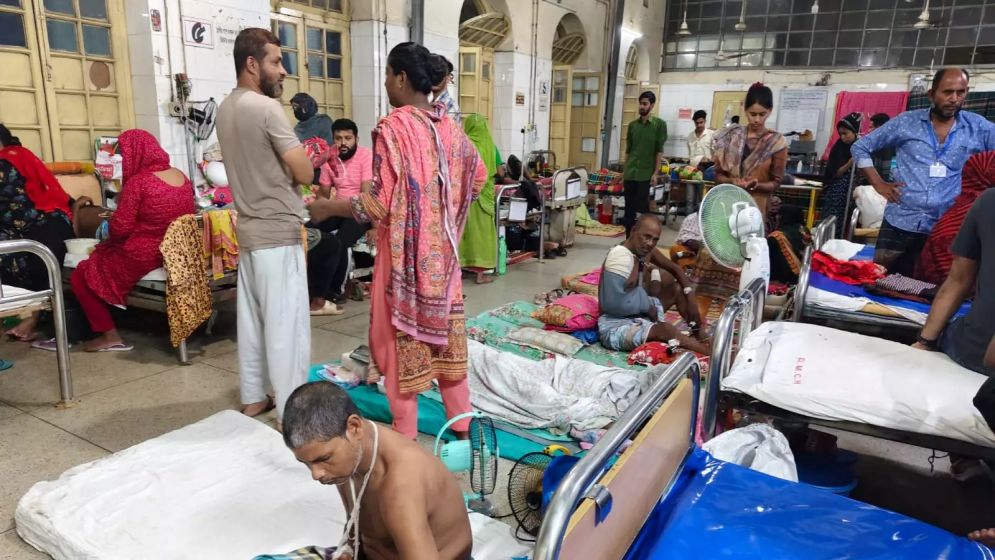Hygiene in Dhaka Medical College Hospital remains a major concern
UNB
Publish: 11 Nov 2024, 10:03 PM

Dhaka, Nov 11 (UNB) - In Bangladesh, hospitals are places where patients
think twice before visiting, due to numerous issues such as hygiene, food
quality, overcrowding and ventilation.
Dhaka Medical College
Hospital (DMCH) ranks top among the facilities blamed for these issues.
"I never think of
visiting public hospitals in Bangladesh, let alone Dhaka Medical College
Hospital," said Tahsin Farzana, a homemaker from a middle-class family.
According to Tahsin,
hospitals should provide relief, but in Bangladesh, particularly at public
facilities, the conditions are distressing. "The washrooms and toilets in
these hospitals are the dirtiest places," she remarked, adding that even attendants
feel unwell after a short stay caring for a patient.
Tahsin expressed
frustration with the status quo, saying, "This situation cannot be allowed
to go on. A hospital should be a place where a patient can heave a sigh of
relief, but to expect that in Bangladesh is simply a dream."
Severe Hygiene Challenges
Cleanliness within
hospitals is critical, covering not only wards and operating theatres but also
public areas like waiting rooms, toilets and cafeterias.
Experts warn that
inadequate hygiene in hospitals contributes to the spread of
healthcare-associated infections (HAIs), including drug-resistant bacteria such
as MRSA.
Routine cleaning using
hypochlorite disinfectants has been proven to reduce infections like C.
difficile, particularly when combined with standard disinfectants.
However, data reveals that
cleanliness in Bangladeshi hospitals is alarmingly deficient. Only 38% of
health facilities nationwide have basic hygiene services, with a stark
difference between government (32%) and private (69%) facilities, as reported
by WHO and Unicef in their latest JMP report.
A recent study by icddr,b
found that only 33% of toilets in government hospitals are clean, with most
lacking disposal options for menstrual hygiene products and facilities for
disabled patients.
The study, conducted across
2,459 toilets in Dhaka's healthcare facilities, highlights an inadequate
user-to-toilet ratio, far exceeding the national standard of 1:6, with
government hospitals reaching a ratio of 214:1.
DMCH's Fight with
Mismanagement
Dhaka Medical College
Hospital, one of the country's most significant public healthcare providers,
faces immense strain.
Patient numbers at DMCH
have almost doubled the hospital's intended capacity, severely impacting the
quality of care. From wards to corridors, patients lie on floors as the
hospital grapples with overcrowding, inadequate beds and a lack of resources.
Hospital director Brigadier
General Asaduzzaman Khan acknowledged the numerous complaints, attributing the
worsening conditions to both overcrowding and insufficient facilities.
"One toilet serves ten
patients. If you accommodate 4,300 patients in a facility designed for 2,600,
along with two or three attendants per patient, the pressure on facilities is
unmanageable," he explained.
Khan also raised concerns
about users' behaviour, stating, "We strive to ensure cleanliness, but
many patients and attendants are unaware of proper hygiene practices, often
leaving waste like sanitary pads and plastic bags in toilets, exacerbating the
problem."
He also mentioned that
staff shortages, especially among the fourth-grade workforce, hinder the
hospital's efforts to maintain cleanliness and order.
A study on sanitation in
Dhaka's major hospitals was conducted by researchers from the University of
Technology Sydney, icddr,b in Bangladesh, and Dhaka Medical College.
It highlights severe issues
with toilet functionality, cleanliness, and accessibility, especially for
outpatient services, with recommendations for improved resources and management
to meet sanitation standards by 2030. The cross-sectional study, conducted
between August and December 2022, evaluated toilets in 10 government and two
private hospitals to assess their functionality, cleanliness, and
user-to-toilet ratio.
The findings revealed that
only 68% of government hospital toilets and 92% of private hospital toilets
were functional. Cleanliness was even more concerning, with only 33% of toilets
in government hospitals and 56% in private hospitals considered clean.
The study also uncovered
high user-to-toilet ratios, particularly in outpatient services, where ratios
were as high as 214:1 in government hospitals and 94:1 in private facilities.
Alarmingly, only 3% of
toilets had bins for menstrual-pad disposal, and less than 1% were equipped for
disabled users.
The researchers emphasise
that improving sanitation facilities in Dhaka's healthcare facilities is
critical to meeting the Sustainable Development Goals (SDGs) by 2030, calling
for increased resources, maintenance staff, and leadership from hospital
administrators to address these shortcomings.
This study underscores the
urgent need for policy interventions to improve basic sanitation and infection
control in healthcare settings in Dhaka.
A Call for Urgent Reforms
The situation at Dhaka
Medical College Hospital reflects a broader crisis within the country's
healthcare system. The poor hygiene standards, staff shortages, budget
constraints, and inadequate facilities at DMCH paint a grim picture of the
healthcare services available to the public.
Addressing these issues
will require significant resource allocation, dedicated maintenance staff, and,
crucially, strong leadership to enforce standards of cleanliness, hygiene, and
patient care. With rising patient numbers and deteriorating conditions, the
need for reform has never been more pressing.
END/UNB/AJ/SAM
